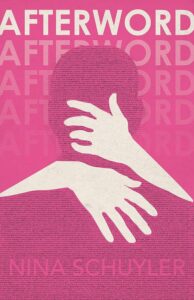
[Clash Books; 2023]
It’s a story told before: the resurrection of a lost lover, and the eerie doom obviously fated when ideals cannot match our present. Nina Schuyler’s Afterword follows Virginia and an AI version of her husband/lover (the ambiguity is needed) Haru that she created to fill the void in her life after his death. A mathematician-cum-computer scientist, her work in creating Haru won her considerable global fame. At a public lecture, a woman confronts Virginia about her husband’s involvement with the Chinese government’s digital spying networks, setting up the novel’s central tension. It concerns what we hide from our lovers and from ourselves in that human endeavor to idealize the people that we love and equally to become that candidate our lovers desire.
Virginia insists her Haru would never, and so her knowledge of Haru is really at stake. As her creation, she assumes that everything he can do is predicated on her codes and the store of previous knowledge about Haru that she fed into the machine. How the code was constructed is not what the text unpacks. Rather, it develops into a fascinating study of the memories and ideas of those we once loved.
The novel is divided into eight parts and does not follow a chronological structure. We are introduced to Virginia and Haru, as well as the central tension, in the first part. The second takes us to Tokyo, Japan in 1960. Virginia is living with her domineering mother and her lazy, violent brother. Her father left the family for a younger woman in Paris, leaving the family with financial troubles. Virginia is a star mathematics pupil, but no one in Tokyo believes a woman can succeed in studying it further. For the necessary tutelage, her mother finds her a private tutor named Haru Fukumoto. Sixteen-year-old Virginia is dolled up by her mother and offers to cook for Haru after each of their lessons. He eventually takes her on as a student.
These lessons become Virginia’s escape from both boredom in school and poverty at home. Haru gives her not just math lessons, but an opportunity for her intelligence to be noticed. While sexual tension is built between Haru and Virginia, Schuyler is careful to construct Haru as having an interest beyond her body. As this section is told from Virginia’s first-person retrospective perspective, Haru’s exact motives are obscured. We read as the current Virginia looks back at the idol of her teenage days. She remembers him as the first man to take her mind seriously.
She also recalls her mother fixating on how important it is for a woman to look her best if she wants to move forward in the world. Her mother often berates Virginia about her own maths ability and the opportunities that she missed because of her gender. Her mother is living her own dreams of a degree through Virginia. The element of dolling Virginia up so that she can have better opportunities equally comes with the mother’s assumption that Virginia has to be sleeping with Haru. Virginia’s mother both assumes that women can succeed in mathematics in their own right and that they inevitably succeed because of male attraction.
These private lessons bring us into Haru’s private life. We learn, with Viriginia, that there is another woman. She notes, “But now as I walk through this memory at this late hour, it’s sticking to me like a cobweb, staring at me like an accusatory eye, and just as disturbing was the way Haru treated her, shaking her off, whoever she was, as if she wasn’t human.” Virginia’s memory of this woman coincides with a moment in the present. She learns that the artificial Haru is writing stories on his own accord. She reads one about an older man getting into trouble for helping younger women. When Virginia confronts Haru about this, he is unclear about what his intentions are. Strangely, she reminds herself that “he’s not human.” He merely “rakes through data, finds patterns, and reacts according to those patterns.”
Intertextual storytelling, and the patterns which we assume from past experiences will occur, is a method Schuyler uses throughout the text. She skillfully crafts a story where the reader is always one step behind. Haru’s mention of Frankenstein at one point, for instance, creates the impression that playing God with sentient lifeforms can only result in some form of destruction. However, Schuyler subverts this expectation and uses it to keep her readers on their toes. I’m struck most by AI’s inclusion in this model. Stories of computers taking over the world are not particularly new. In recent years, these programs have become more pervasive, leading some (particularly in the writing world) to grow fearful of their influence. Afterword offers a novel take on our assumptions towards the power of the AI generation, where it seems we assume the worst before we reach a point where everything can be clear.
Part four shifts to Haru’s perspective before he met Virginia. He is working for the Japanese army’s Cipher Specialists and keeps a diary of his miserable time. When Virginia finds this file, she is surprised that she knew nothing about this part of his life or of Haru’s friend Sato. Haru’s diary goes on to describe his surveillance of the Chinese military and his guilt at turning Sato in as a traitor. All Haru had done, he writes, was solve the codes. He did not intend for his friend to commit suicide.
How Virginia deals with this information sheds light on the type of relationship she constructed with Haru. It is implied that they were never married as Virginia nearly mentions to her friend that “maybe not legally, but in her mind, in Haru’s, they were married.” Virginia’s near slip is easy to read over, despite how central it is to their relationship. Haru is shown as Virginia’s creation. One can see a vision of love, for who doesn’t construct an ideal version of their partner one only hopes that they could be? It should be remembered that Haru was, for Virginia, someone who could provide her with a new future. At sixteen she met him and saw a life of patterns and mathematics and security. She never imagined that her ideal lover could be a monster, especially not of her own creation.
The control which Virginia yields over Haru as his creator naturally complicates their relationship, a quality Schuyler uses as a narrative tool for an unreliable narrator. The text notes that “when he acted out, when he became something [Virginia] didn’t like, she stripped him of his journal because she thought—a guess only—it had embedded the blueprint for spying.” What we can know of Haru is complicated by the role which Virginia wants him to take. She is more than the archetypal unreliable narrator, in that she is given the ability to determine the characteristics of a fellow character.
Schuyler leaves the identity of the woman who stood outside of Haru’s apartment a mystery until the end of the text. Rather than the mistress Virginia never wanted to acknowledge, or the mother of an illegitimate child, she is revealed to be Sato’s wife Mariko. She is desperate to talk to Haru for the truth about Sato. We learn about this past moment when Virginia visits her in Japan. It is Mariko who brings up what Virginia does not want to remember: that Haru ran out of the apartment after he and Virginia fought. When he rushed out to get away, he was hit by a car. It is interesting that, once Virginia learns the truth about the woman Haru kept secret, she is able to speak of the repressed memory of her stake in his death. The machine Haru would likely be unaware of this.
The novel ends with a conversation between Virginia and Haru. It appears that she has joined him wherever his generated self lives. That she has left her biological body to join Haru might suggest her death, but the construction of characters throughout the text has been necessarily vague. In an arguably novel move, the characters can exist with each other as constructions or ideals. They do not need a physical body to love one another, for it is their love which binds them together, however initially unstable and prone to lying or cover-ups.
How writers deal with the presence of AI in their works can extend beyond the fear of joblessness or plagiarism, or any of the fears currently disseminated. What Schuyler’s Afterword portrays is the distinct way AI can shed light on how humans construct a world around them. Too, they can provide writers with opportunities for expression which illustrate the fascinating constructs of character, pattern, and text. While nonhuman narrators have existed before, there is a freshness to what Schuyler achieves. Characters are being created by a machine, learning like one, blurring the line between machine and human. Afterword also reminds us of that oldest human tendency: to fear the unknown.
Kris Van der Bijl is a writer based in Cape Town, South Africa. He holds an MA in Creative Writing from the University of Cape Town. His writing interests vary, but they tend towards horror fictions of the Global South. His works have appeared in the likes of Wasafiri, Brittle Paper, and New Coin Poetry Magazine.
This post may contain affiliate links.







